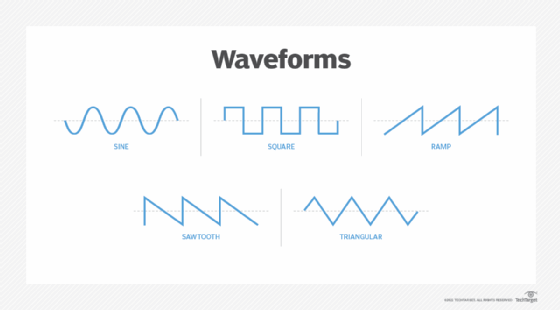harmonic
What is a harmonic?
A harmonic is a wave or signal whose frequency is an integral (whole number) multiple of the frequency of the same reference signal or wave. As part of the harmonic series, the term can also refer to the ratio of the frequency of such a signal or wave to the frequency of the reference signal or wave.
The fundamental frequency or original wave is known as the first, or 1st,, harmonic. The following harmonics are called higher harmonics. The fundamental frequency of all harmonics is periodic, and the total number of harmonics is also periodic at that specific frequency.
The term harmonic is used across different fields such as electronic power transmission, music, radio and all technologies that use waves in other forms. Their frequencies always relate to these waves and are always found in whole-numbered multiples.
For example, f represents the main, or fundamental, frequency of an alternating current (AC) signal, electromagnetic field or sound wave. This frequency is measured in hertz and is the frequency at which it contains most of the energy. It can also represent when the signal is defined to occur. If the signal is displayed on an oscilloscope, the waveform will appear to repeat at a rate corresponding to f Hz.

For a signal whose fundamental frequency is f, the second harmonic has a frequency of 2f. The third harmonic has a frequency of 3f, and so on. Furthermore, w represents the wavelength of the signal or wave in a specified medium. The second harmonic has a wavelength of w/2, and the third harmonic has a wavelength of w/3. Signals occurring at frequencies of 2f, 4f, 6f and more are called even harmonics. Signals at frequencies of 3f, 5f and 7f are called odd harmonics. A signal can, in theory, have an infinite number of harmonics.
Nearly all signals contain energy at harmonic frequencies, in addition to the energy at the fundamental frequency. If it contains all the energy in a signal at the fundamental frequency, then that signal is a perfect sine wave. If the signal is not a perfect sine wave, then some energy is contained in the harmonics. Some waveforms contain large amounts of energy at harmonic frequencies, for example, square waves, sawtooth waves and triangular waves.

In wireless communications and broadcasting, transmitters were designed to emit a minimum of energy at harmonic frequencies. Typically, wireless devices use only one frequency. Signal output at harmonic frequencies can cause interference with other communications or broadcasting protocols.
For example, a broadcast signal at 90.5 megahertz (MHz) in the standard FM band would have a second harmonic at 181 MHz, a third harmonic at 271.5 MHz, a fourth harmonic at 362 MHz and so on. Some or all these harmonic signals, depending on their strength, could disrupt activities in other wireless services.
Other uses of harmonic
Harmonic has several additional meanings, including:
What is harmonic distortion?
In electrical distribution systems, harmonic distortion is a standard voltage and current variation resulting from frequency changes. For example, it can be a deviation from typical sinusoidal variations in voltages or currents.
What is harmonic motion?
In physics, harmonic motion or simple harmonic motion represents repetitive movement -- back and forth --- through a central or position equilibrium. In this case, the maximum displacement on one side is equal to the total displacement on the opposite side.
The interval of each completed vibration is always the same. The force that creates the motion always directs to the central position or equilibrium position. It is always directly proportional to the distance from it.
What is a harmonic balancer?
In automobiles, a harmonic balancer is a drive component that connects to the engine crankshaft. Often called crankshaft damper, torsional damper or vibration damper, the harmonic balancer helps reduce engine vibration. Sometimes, a harmonic balancer also works like a pulley for drive belts.
What is a harmonic series?
In mathematics, a harmonic series describes the divergent infinite series of overtones or harmonics in music. In this scenario, the vibrating string wavelengths of the overtones are 12, 13, 14,etc. of the string's fundamental wavelength.
What is harmonic in an electrical context?
Harmonics describe the distortion of normal electrical current waveforms. These are generally transmitted by nonlinear loads.
Examples of nonlinear loads include:
- Battery chargers
- Personal computers
- Laser printers
- Variable speed motors and drives
- Switch-mode power supplies (SMPS)
Learn all about Wi-Fi 6 and 5G in the enterprise. Explore why routed optical networking tactic could be game changer and take a look at Wi-Fi design best practices.
